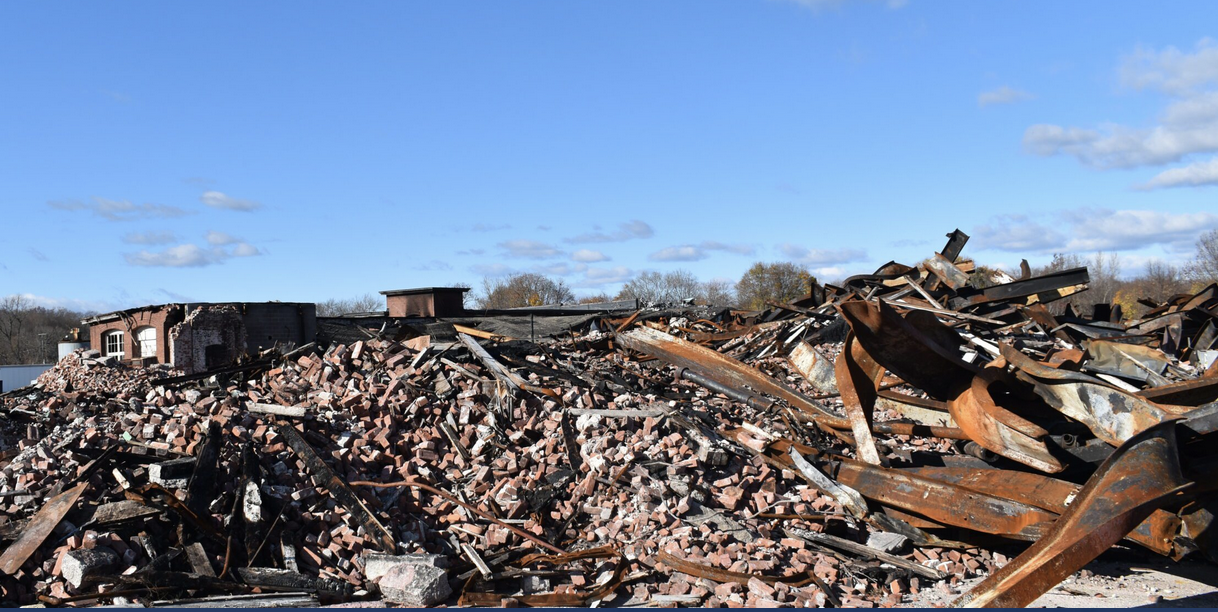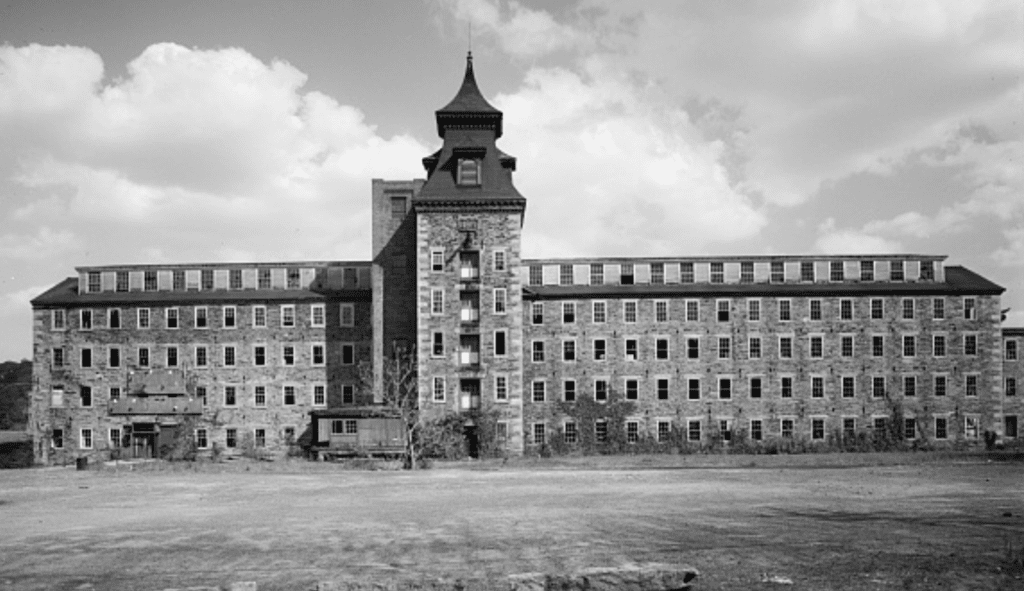Search Posts
Recent Posts
- Rhode Island Weather for June 4, 2025 – Jack Donnelly June 4, 2025
- Sour Grapes time! – Tim Jones (meet Tim at AnimeCon) June 4, 2025
- Lawsuit filed to stop Empire Wind Project by 4 environmental groups and fishermen June 4, 2025
- It is what it is: 6.4.25 – Jen Brien June 4, 2025
- New ALS treatment by PathMaker Neurosystems. Co. funded by RI Life Sciences Hub to come to RI. June 3, 2025
Categories
Subscribe!
Thanks for subscribing! Please check your email for further instructions.

Vacant Mills Can Hold Toxic Secrets – ecoRINews
by Bonnie Phillips, ecoRI News – Originally published by ecoRINews.Read more atecoRI.org.
Photo: Bonnie Phillips – Piles of rubble are all that are left of the mill at 20 Privilege St. in Woonsocket.
In July, a vacant mill at 20 Privilege St. was destroyed by fire.
The brick building, built in 1902 near the border with Blackstone, Mass., had been most recently owned by CNC International, an organic chemical manufacturing company, according to the Rhode Island Department of Environmental Management.
The state fire marshal is investigating the cause of the fire, during which neighbors reported seeing blue and green flames, which raised concerns about what was being stored in the 220,000-square-foot building.
“I’m concerned about the health of residents and the environment,†local resident Veronicka Vega said.
According to Dun & Bradstreet, which tracks business analytics, CNC International manufactured chemicals used in cleaning products such as soap and dishwashing detergent. The four-story building was destroyed in the fire, and the fenced-off area now contains piles of bricks and other debris.
The fire highlights an issue that haunts communities such as Woonsocket, littered with old mill buildings — what’s left behind when a mill closes?
The boom times
The city of Woonsocket was formed in 1888 by combining six mill villages that grew up along the Blackstone River in the area around Woonsocket Falls.
In 1793, when Samuel Slater built the first water-powered textile mill on the Blackstone River in Pawtucket, it formed the basis for a new economy along the river. With a 400-foot drop in elevation from Worcester to Providence, the river was a natural site on which to build mills in the days before steam-powered machines. The steep drop and many falls provided ideal conditions to power small textile mills, around which the mill villages developed. The first textile mill in Woonsocket, the Social Manufacturing Co., was built on the Mill River in 1810, according to Woonsocket.org. By the mid-19th century, Woonsocket had become one of the largest textile manufacturing centers in the United States.
By 1842 there were 20 mills in Woonsocket, most producing cotton fabric, and that growth would continue thanks to the opening of the Providence & Worcester Railroad in 1847. Eventually, the six mill villages split from the towns that controlled them — Smithfield and Cumberland. In 1867, the Cumberland villages, including Woonsocket Falls, Social, and Jenckesville, officially became the town of Woonsocket. In 1871, the three Smithfield villages — Hamlet, Bernon, and Globe — were added, and Woonsocket became a city in 1888.
In the 1920s, competition from southern mills, labor conflicts, and antiquated facilities contributed to the collapse of cotton manufacturing. Woonsocket’s largest producer, the Social Mill, closed in 1927. Several factories, including the Social and Globe mills, were torn down during the Great Depression. World War II briefly brought back prosperity as local mills produced fabric for the troops.
After the boom
Once the pride of the city, Woonsocket’s mills faced different fates after WWII.
The Woonsocket Falls Village and its mill buildings became the city’s downtown hub and business district. The Bernon Mill was bought by Blackstone Valley Gas and Electric.

Of the three large mills that once dominated the city’s Social district — the Social and Nourse mills and the American Wringer Co. — two are gone. The Social Mill, the city’s first textile mill, which was rebuilt after a fire in 1874, closed in the 1920s. The Nourse Mill burned down in 1956. The American Wringer Co. is now residential, retail, and recreational space.
The Globe Mill, between Front Street and the Blackstone River, was demolished in the 1920s.
The buildings that stand today in what was once Hamlet Mill Millage, near Hamlet Avenue and Davidson Street, were built by French and Belgian companies drawn to Woonsocket thanks to the city’s large French-speaking workforce. Lafayette Worsted and French Worsted still produce yarn using the “French process.â€
Owners cited
The owner of the Privilege Street mill building was cited by DEM twice over storage of hazardous chemicals at the site.
According to DEM, the agency received a complaint in June 2017 about the possible storage of hazardous chemicals. A DEM inspector visited the mill and found the company had violated the state’s hazardous waste regulations, according to a notice of intent to enforce sent to CNC.
It was unclear what, if any, actions the company took to mitigate the findings. No one associated with CNC International could be reached for comment.
A 2019 environmental assessment from Fuss & O’Neill said lead-based paint, asbestos, and mercury were found in the building.
In July 2022 the company was again cited by DEM for hazardous waste violations, including having “spent isopropyl alcohol and other potentially hazardous chemicals†in the building. DEM ordered CNC to remove the hazardous waste by August.
The company did so, according to Evan LaCross, a DEM spokesperson, and “continued to remove the waste at the property after the deadline noted in the letter.â€
LaCross said the building “was known to previously contain laboratory pack chemical waste as well as drums consisting of miscellaneous non-hazardous waste, hazardous waste, and oil. DEM had been working with the current owner of the property, 20 Privilege St. LLC, which was performing a clean-out of excess chemicals left behind by the prior owner of the property.â€
LaCross said the property owner hired a contractor to remove containers holding chemical waste and products.
“DEM has confirmed with the property owner and the contractor that the remaining hazardous waste was removed from the property prior to the fire,†LaCross said. “It is believed that any drums which may have remained in the building during the fire were non-hazardous waste and rainwater.
“The last active production activity at the site involved the manufacture of a surfactant for the automatic car washing industry and the products involved did not meet the definition of hazardous waste.â€
Woonsocket Fire Chief Robert Cahill said the Fire Department had been working with “DEM and the prior owner over the last couple of years to remove and dispose of whatever chemicals were left†at the site.
“We were concerned about the contents of the mill, knowing it previously housed chemicals,†Cahill said. “There were heavy timbers that made up the construction with steel I beams, but [we’re not] not 100% sure as to what may have caused the ‘blue and green’ flames. All fires emit toxins into the air and should be of concern. With a fire of this size and knowing the previous contents, we did our best to contain/control the hazards.â€
‘Repurpose them’
The Privilege Street building, now a pile of rubble, is another mill lost in Woonsocket.
“It’s one of countless examples,†Woonsocket native and documentary filmmaker Christian de Rezendes told a local TV station after the fire. “Throughout the Blackstone Valley, beautiful mill buildings of a particular era [are] just gone.â€
De Rezendes said old mill buildings can become an important part of a community.
“We need to do our best to find ways to repurpose them, either for commercial or residential,†he said.
